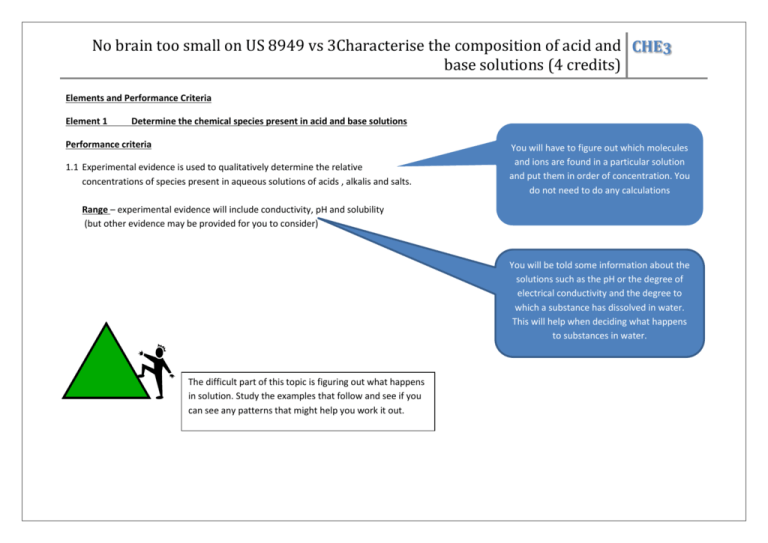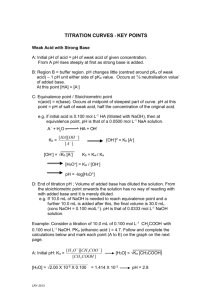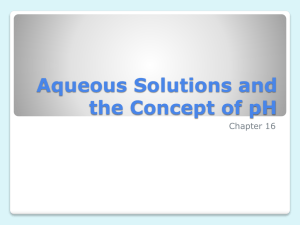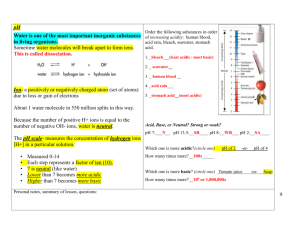4 credits - No Brain Too Small
advertisement

No brain too small on US 8949 vs 3Characterise the composition of acid and CHE3 base solutions (4 credits) Elements and Performance Criteria Element 1 Determine the chemical species present in acid and base solutions Performance criteria 1.1 Experimental evidence is used to qualitatively determine the relative concentrations of species present in aqueous solutions of acids , alkalis and salts. You will have to figure out which molecules and ions are found in a particular solution and put them in order of concentration. You do not need to do any calculations Range – experimental evidence will include conductivity, pH and solubility (but other evidence may be provided for you to consider) You will be told some information about the solutions such as the pH or the degree of electrical conductivity and the degree to which a substance has dissolved in water. This will help when deciding what happens to substances in water. The difficult part of this topic is figuring out what happens in solution. Study the examples that follow and see if you can see any patterns that might help you work it out. No brain too small on US 8949 vs 3Characterise the composition of acid and CHE3 base solutions (4 credits) Soluble Ionic Solids When an ionic crystal dissolves the ions become surrounded by water molecules. We say that the ions are solvated. Note – this is a 2 step process that involves separating the ions from each other in the crystal, followed by hydration (surrounding ions with water molecules) Dissolves completely Examples Na+ (aq) + Cl- (aq) NaCl(s) 1 mole dissolves to produce 1 mole of Na+ and 1 mole of Cl- ions Mg2+ (aq) + 2 Cl-(aq) MgCl2(s) 1 mole dissolves to produce 1 mole of Mg2+ and 2 moles of Cl- ions Don’t forget that the other species in the solution will be H+ ions and OH- ions formed from the dissociation of water molecules. Eg H2O(l) H+(aq) + OH- (aq) ( or 2H2O(l) H3O+ (aq) + OH- (aq) ). At 25oC Kw for water is 1 x 10-14 which makes the concentrations of the hydroxide ions and the H+ or hydronium ions both at 1 x 10-7 mol L-1 If the pH of the solutions formed is 7 then we can deduce that the ions have not acted as a weak acid or base. So in a solution of 1 mol L-1 NaCl(aq) we would have [Na+] = [Cl-] > [H+] = [OH-] And in a solution of 1 mol L-1 MgCl2(aq) we would have [Cl-] > [Mg2+] > [H+] = [OH-] The electrical conductivity of these solutions will be high due to the high concentration of charge carriers (ions free to move). MgCl2 has a higher concentration of dissolved ions and will have the higher electrical conductivity. No brain too small on US 8949 vs 3Characterise the composition of acid and CHE3 base solutions (4 credits) Soluble molecular solids eg glucose bonded together. glucose dissolves completely in water to produce a solution of glucose molecules and water molecules hydrogen We could write the dissolving process as C6H12O6 (s) +H2O(l) C6H12O6 (aq) 1 mole of glucose 1 mole of dissolved glucose There is no further reaction between water molecules and glucose molecules so the resulting pH of the solution is 7. We also deduce that the [H+] = [OH-] from the dissociation of some of the water molecules in the solution. This gives the following relative order of concentrations [C6H12O6 (aq)] > [H+] = [OH-] . This solution is a very poor electrical conductor due to the very low concentrations of ions H+ and OH- ( 1 x 10-7 mol L-1 each). The glucose molecules carry no overall electrical charge. Sometimes a molecular substance dissolves and then a transfer of a proton takes place. In this case the resulting pH will not be 7 and new species (ions) will form which will affect the electrical conductivity of the solution. Example – ammonia (NH3) ammonia is a covalent molecule soluble in water. The ammonia dissolves in water NH3 (g) NH3 (aq) And the dissolved ammonia is a weak base (proton acceptor) NH3 (aq) + H2O (l) NH4+ (aq) + OH- (aq) Ammonia is a weak base and most molecules do not react (accept a proton). The relative order of [species] is :[NH3 (aq)] > [NH4+ (aq) ] = [OH- (aq)] > [H+ (aq)] Approximately same concentration The concentration of hydroxide increases and so the concentration of H+ ions in the water must decrease to maintain Kw ( Kw = [H+] [OH-]). The electrical conductivity is poor ( but better than water) because the concentration of ions ( charge carriers) is still low. The pH will be greater than 7 No brain too small on US 8949 vs 3Characterise the composition of acid and CHE3 base solutions (4 credits) Example ethanoic acid – ethanoic acid is a covalent molecule soluble in water. The ethanoic acid dissolves in water CH3COOH (l) CH3COOH (aq) And the dissolved ethanoic acid is a weak acid (proton donator) CH3COOH (aq) + H2O (l) CH3COO- (aq) + H3O+ (aq) Because the ethanoic acid is a weak acid, only a few ethanoic acid molecules donate protons. The relative order of [species] is :[CH3COOH (aq] > [CH3COO- (aq) The concentration of hydronium ions increases and so the concentration of OHions in the water must decrease to maintain Kw ( Kw = [H3O+] [OH-]). The pH will be less than 7. The solution will be a poor electrical conductor (low concentration of ions). ] = [H3O+ (aq) ] > [OH- (aq) ] Approx. same concentration Watch out for salts which dissolve in water to produce an ion which is a weak acid or weak base. Example Sodium ethanoate. CH3COONa This is an ionic substance. It dissolves in water to form ethanoate and sodium ions in equal concentrations. Some of the ethanoate ions react with water and the pH of the solution changes. Ethanoate is a weak base and so a proton is accepted by each ethanoate ion. CH3COONa (s) CH3COO- (aq) + Na+ (aq) Then CH3COO- (aq) + H2O (l) CH3COOH (aq) + OH- (aq) The relative order of [species] is :[Na+ (aq] = [CH3COO- (aq)] > [CH3COOH (aq)] = [OH- (aq) ] > [H+ (aq) ] Approx. same concentration Approx. same concentration The concentration of hydroxide ions increases and so the concentration of H+ ions in the water must decrease to maintain Kw ( Kw = [H3O+] [OH-]). The pH will be more than 7. The solution will be a good electrical conductor ( high concentrations of ions from the ionic salt). No brain too small on US 8949 vs 3Characterise the composition of acid and CHE3 base solutions (4 credits) Example Ammonium Chloride This is an ionic substance. It dissolves in water to form ammonium ions and chloride ions in equal concentrations. Some of the ammonium ions react with water and the pH of the solution changes. Ammonium ion is a weak acid and so a proton is donated to water. NH4Cl (s) NH4+ (aq) + Cl – (aq) Then NH4+ (aq) + H2O (l) NH3 (aq) + H3O+ (aq) The concentration of hydronium ions increases and so the concentration of OH- ions in the water must decrease to maintain Kw ( Kw = [H3O+] [OH-]). The pH will be less than 7. The solution will be a good electrical conductor (high concentrations of ions from the dissolved ionic salt). Approx. same concentration The relative order of [species] is :[NH4+ (aq) ] = [Cl- (aq)] > [NH3 (aq)] = [H3O+ (aq) ] > [OH (aq) ] The trick to understanding if a dissolved species reacts with water is to look at the experimental evidence supplied in the question to see if the pH of the solution has changed from 7. If it has then one of the ions in the solution must have donated a proton to water to make hydronium ions ( pH decreases and is less than 7) or the ion has accepted a proton from water to produce hydroxide ions ( pH increases). A high electrical conductivity indicates a high concentration of ions coming from a dissolved salt. No brain too small on US 8949 vs 3Characterise the composition of acid and CHE3 base solutions (4 credits) Element 1.2 Ka or pKa values are used to calculate the pH of weak acid and alkaline solutions and vice versa. Example Calculate the pH of a 0.120 mol L-1 solution of ethanoic acid. Ka (CH3COOH) = 1.8 x 10-5 Ethanoic is a weak acid, and so knowledge of what it does in solution will be helpful in solving this problem. Step 1 Step 2 Write the equation for a weak acid in solution Write the equilibrium expression for Ka CH3COOH + H2O CH3COO- + H3O+ - + Ka = [CH3COO ] [H3O ] We ignore water in the equilibrium expression [CH3COOH] Step 3 write x mol L-1 for the [CH3COO-] and [H3O+] and substitute in the known values for Ka 1.8 x 10-5 = (x mol L-1)2 0.120 mol L-1 and [CH3COOH] from the question. Step 4 rearrange to find x which gives us the [H3O+] needed to calculate the pH x mol L-1= √1.8 𝐸 − 5 𝑥 0.120 = 1.47 x 10-3 mol L-1 Step 5 calculate the pH of the solution pH = -1og [H3O+] = -log (1.47 x 10-3) = 2.83 Because we are dealing with weak acids with low Ka values, not much of the original acid actually dissociates so we assume the final concentration of the weak acid is the same as it was at the beginning. This simplifies the maths and makes little difference to the final answer. No brain too small on US 8949 vs 3Characterise the composition of acid and CHE3 base solutions (4 credits) Element 1.2 Ka or pKa values are used to calculate the pH of weak acid and alkaline solutions and vice versa. Question What happens if we are told the pKa of a weak acid and not the Ka? Answer Ka is calculated from 10-pKa Example What about an alkaline solution? Eg calculate the pH of a 0.15 mol L-1 solution of ammonia (NH3) in water. (Ka (NH4+)= 5.62 x 10-10) Step 1 Write the equation for the base in water NH3 + H2O NH4+ OH- Step 2 Write the equilibrium expression for Kb Kb = [NH4+] [OH-] example the pKa of Formic acid is 3.8 so Ka = 10 -3.8 = 1.58 x 10-4 [ NH3] Step 3 the [NH4+] = [OH-] = x mol L-1 Kb = x2 and Kb is 10-14 / Ka = 1.80 x 10-5 [NH3] Step 4 rearrange and solve for x which gives the [OH-] x = √1.80 𝐸 − 5 𝑥 0.15 x = 1.64 x 10-3 mol L-1 Step 5 Find [H3O+] = Kw / [OH-] [H3O+] = 1 x 10-14/1.64 x 10-3 mol L-1 [H3O+] = 7.00 x 10-12 Step 6 calculate the pH pH = -log(7.00 x 10-12) = 11.2 No brain too small on US 8949 vs 3Characterise the composition of acid and CHE3 base solutions (4 credits) Element 2 Characterise acid-base titration curves range weak acid / weak base titration cuves are excluded Performance criteria 2.1 The pH points of acid-base titration curves are qualitatively predicted. Range – any two of; initial pH, equivalent point, buffer region 2.2 Indicators which will change colour at the equivalence point are selected for a given acid-base titration. You don’t necessarily need to do calculations for this part of the unit standard but it might help to locate some of the points on the titration curve graph. For 2.2 a simple working knowledge of how indicators work will be sufficient to select the most appropriate indicator for a particular titration. Vocabulary List pH point titration curve qualitatively equivalent point buffer region initial pH indicator meaning a point on the graph to show the pH at a particular part of the titration (within + or – 1.5 pH units) a graph of pH vs volume added (of acid or base) to an acid or base in the flask. It shows how pH changes during a titration means approximately in this context i.e. you do not have to show calculations or method of working to get your answer the place on the graph which shows the pH and volume when the 2 reactants (from burette and flask) have exactly reacted with each other according to the amounts given in the balanced equation a region where the pH in a pH curve is changing very slowly due to presence of a weak acid and its conjugate base or weak base and its conjugate acid in the flask means the starting pH of the solution in the flask before anything is added from the base a substance that will change colour over a small pH range which is added to a solution to indicate when the equivalence point has been reached ( if the correct indicator has been selected – see later) No brain too small on US 8949 vs 3Characterise the composition of acid and CHE3 base solutions (4 credits) PC2.1 Titration Curves - there are 3 basic shapes to know for the unit standard. In each of the above the acid must be in the conical flask and the base in the burette! (initial pH is <7). If the base is placed in the flask then the shapes of the curves must be reversed and the initial pH must be >7 No brain too small on US 8949 vs 3Characterise the composition of acid and CHE3 base solutions (4 credits) PC2.1 Estimating initial pH values – what have you got in the flask? Strong acid – pH = -log [H+] the acid has fully dissociated so the pH will be –log of the concentration of the acid given in the question. Or guesstimate a pH of 1 Weak acid H+ = √𝐾𝑎 𝑥 [𝐻𝐴] then pH = -log [H+]. Or guesstimate a pH of 3 (you are allowed error of approx. 1.5 pH units on your graph). Strong Base pH = 14 – pOH pOH = -log [OH-] which is the same as -log [base] Weak base Kb=Kw/Ka OH- = √𝐾𝑏 𝑥 [𝑏𝑎𝑠𝑒] then pH =14 - log [OH-]. (Or (Or guesstimate a pH of 13). guesstimate a pH of 9) Or – guesstimate a pH of 1 For those keen on calculations the data you will need is supplied in the question or on the titration curve. Or guesstimate a pH of 3 (you are allowed error of approx. 1.5 pH units on your graph). No brain too small on US 8949 vs 3Characterise the composition of acid and CHE3 base solutions (4 credits) PC2.1 example question Here is a typical question:Sketch the titration curves for each of the acid-base titrations given below. In each case, estimate the approximate pH value for the initial solution, the equivalence point and the buffer region and use these to sketch the curve. Note: No precise calculations are required, but pH values must be within an appropriate range (plus or minus 1.5 pH units of correct value). Addition of 0.100 mol L-1 NaOH to 10.0 mL of 0.100 mol L-1 ethanoic acid. pKa(ethanoic acid) = 4.70. What you need to decide 1) What type of pH curve is it strong acid/strong base 2) What is in the flask? 0.100 mol L-1 ethanoic acid strong acid /weak base strong base/ weak acid or 0.100 mol L-1 NaOH So the guesstimate pH in the flask will be that of a weak acid ie 3 The calculated pH will be -log √𝐾𝑎 𝑥 [𝑒𝑡ℎ𝑎𝑛𝑜𝑖𝑐 𝑎𝑐𝑖𝑑] pH = ( remember that Ka is 10 – pKa) so Ka is 10 – 4.70 = 2.00 x 10-5 pH = 2.85 ( not too far off the guess of 3!). 3) Where is the equivalence point? CH3COOH + NaOH = CH3COONa + H2O this is a reacting ration of 1 :1 so 10.0 mL of 0.100 mol L-1 ethanoic acid will require the same volume of an equal concentration of a base to react with it. I.e. equivalence point is reached when 10 mL of acid + 10 mL of base have reacted ie at 10 mL on the volume of base added axis. (For those with calculators the amount of acid or base (n) = cV so equal volumes at the same concentration must contain the same amount). No brain too small on US 8949 vs 3Characterise the composition of acid and CHE3 base solutions (4 credits) 4) What is the pH at the equivalence point? - CH3COOH + NaOH = CH3COONa + H2O This contains ethanoate which reacts with water to give an alkaline solution – so guesstimate a pH of 9 5) Where is the buffer region? CH3COOH + NaOH = CH3COONa + H2O A buffer is a solution of a weak acid and its conjugate base – so in the above equation weak acid is CH3COO H And weak base is CH3COOThe buffer region is centred halfway to the equivalence point because at that point we will have half neutralised the acid in the flask so the concentrations of CH3COOH to CH3COO- will be equal. The pH at the middle of the buffer region is given by the pKa of the weak acid – in this question pKa(CH3COOH) is 4.70 , so that is the pH at this part of the graph. No brain too small on US 8949 vs 3Characterise the composition of acid and CHE3 base solutions (4 credits) So – the sketch will be as follows (make sure it is the general shape of a weak acid / strong base curve) pH 10 pH guesstimate of 9 at equivalence point 88 Initial pH = 3 (guesstimate) when 10 mL base added to the flask 6 4 Middle of buffer region at pH of 4.70 after 5 mL base added 2 0 5 10 15 20 Volume of base added (mL) No brain too small on US 8949 vs 3Characterise the composition of acid and CHE3 base solutions (4 credits) PC2.2 Indicators which will change colour at the equivalence point are selected for a given acid-base titration Indicators are weak acids (HIn) with a conjugate base (In-) that have different colours to each other. (In stands for indicator) When the concentration of the conjugate acid form = concentration of the conjugate base the indicator is half way between the 2 colours of the acid and conjugate base. This is an intermediate colour. In reality the indicator will change colour over a range of 1pH unit above and below the pKa of the indicator. Look at the examples below to follow this. Indicator is methyl orange HIn Colours red + H2O H3O+ + Inyellow When [HIn] = [In-] the intermediate colour is orange The pKa of methyl red is 5.1 To use an indicator we want the pH range over which it changes colour to coincide with the pH at the equivalence point of our titration. Look at the following example to follow this idea. No brain too small on US 8949 vs 3Characterise the composition of acid and CHE3 base solutions (4 credits) This is a simple sketch of an acid – base titration with the base in the flask. It has the characteristic shape of a strong acid / strong base titration curve. Because the pH change about the equivalence point is so large both methyl orange (pKa 3.7) and phenolphthalein (pKa 9.6) could be used as both indicators would change colour at the appropriate point in the titration. Source www.chemguide.co.uk This a strong acid / weak base titration curve. At the equivalence point only methyl orange ( pKa 3.7) will change colour. The phenolphthalein (pKa 9.6) changes colour before the equivalence point in the titration is reached. Diagram source www.chemguide.co.uk Summary – a suitable indicator is one which changes colour during the vertical part of the titration curve. Look for an indicator with a pKa close to the pH at the equivalence point.









